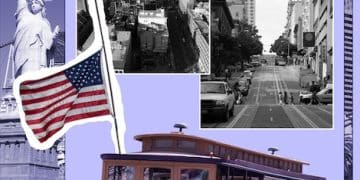The New Deal’s Enduring Impact: Social Safety Nets in 2025

The Legacy of the New Deal: Examining Its Impact on 2025 Social Safety Nets illustrates how policies enacted during the Great Depression continue to shape modern American social security, influencing debates around economic inequality, healthcare access, and social welfare programs in the United States.
The Legacy of the New Deal: Examining Its Impact on 2025 Social Safety Nets reveals the lasting influence of President Franklin D. Roosevelt’s transformative policies. Understanding this legacy is crucial as we navigate the future of social security.
Understanding the New Deal: A Brief Overview
The New Deal, a series of programs and projects enacted in the United States during the Great Depression, fundamentally reshaped the relationship between the government and its citizens. It was a response to unprecedented economic hardship and aimed to provide relief, recovery, and reform.
Beyond immediate assistance, the New Deal established foundational programs that continue to influence social safety nets today. Its success and failures are a constant point of reference in debates about government intervention and economic policy.
The Core Principles of the New Deal
At its core, the New Deal operated on several key principles, most of which involved interventions into the market and the economy to ensure some form of social support. These principles underpinned the vast array of programs and policies enacted during Roosevelt’s presidency.
- Government Intervention: The New Deal marked a significant shift toward government intervention in the economy, a departure from the laissez-faire approach that had previously defined American economic policy.
- Social Security: Establishing a baseline level of economic security for all citizens, through social insurance programs and direct aid, formed a central tenet.
- Economic Regulation: The New Deal sought to regulate key industries, such as banking and agriculture, to prevent future economic crises and protect consumers and producers.
Key Programs and Initiatives
The New Deal encompassed a wide range of programs and initiatives, each targeting specific aspects of the economic crisis. These initiatives laid the groundwork for many of the social programs we rely on today.
- Social Security Act (SSA): Providing old-age pensions, unemployment insurance, and aid to families with dependent children, the SSA remains one of the most significant and enduring legacies of the New Deal.
- Works Progress Administration (WPA): Employing millions of Americans in public works projects, the WPA built infrastructure, created art, and provided valuable skills training.
- Civilian Conservation Corps (CCC): Focused on conservation and natural resource management, the CCC employed young men in projects that improved national parks, forests, and other public lands.
In conclusion, the New Deal was a transformative period in American history, one that continues to shape our understanding of the role of government in ensuring social and economic well-being. Its programs and principles serve as a foundation for the ongoing evolution of social safety nets.
The Enduring Impact on Modern Social Security
The New Deal’s legacy extends far beyond the 1930s, profoundly influencing the structure and scope of modern social security programs. Its impact is evident in the ongoing debates about the role of government in providing a safety net for vulnerable populations.
By establishing the principle of government responsibility for social welfare, the New Deal set the stage for the expansion of social security over the subsequent decades.
The Social Security Act: A Cornerstone of Modern Relief
The Social Security Act of 1935 remains the cornerstone of modern social security in the United States. Its provisions for old-age pensions, unemployment insurance, and aid to families with dependent children continue to provide crucial support to millions of Americans.
While the SSA has been amended and expanded over the years, its core principles remain intact: that workers contribute to a common fund and receive benefits based on their contributions and needs.
Expansion and Evolution of Social Security
Since its inception, Social Security has evolved to include a broader range of benefits and protections. Medicare, established in 1965, provides health insurance to seniors, while Supplemental Security Income (SSI) offers assistance to low-income individuals with disabilities. These programs build upon the foundation laid by the New Deal. The concept of an earned benefit, where workers are entitled to some basic level of benefit regardless of income, is also an important component of the current system and one that differentiates it from programs that are narrowly focused on welfare.
- Medicare: Offers health insurance to seniors.
- Supplemental Security Income (SSI): Provides assistance to low-income individuals with disabilities.
- Unemployment Benefits: Provides temporary assistance to workers while seeking employment.

In summary, the Social Security Act continues to be the foundation for income and social support for a variety of Americans, and its existence stands as a monument to the New Deal era.
Healthcare Access: From the New Deal to Obamacare
The New Deal did not establish universal healthcare, but it laid the groundwork for future efforts to expand healthcare access in the United States. Its focus on social welfare and government responsibility for the well-being of citizens paved the way for later initiatives.
Examining the legacy of the New Deal offers insights into the challenges and opportunities facing healthcare reform today.
Early Healthcare Initiatives during the New Deal
While the New Deal did not include comprehensive healthcare legislation, it did address healthcare needs through various programs. The WPA and CCC, for example, provided medical care to their workers, while the Public Works Administration (PWA) funded the construction of hospitals and healthcare facilities. During the New Deal period, there was also an effort to improve basic sanitation within many cities, which provided some basic level of protection to public health.
These initiatives demonstrated the government’s willingness to address healthcare concerns, albeit in a limited and piecemeal fashion.
The Affordable Care Act (ACA) and the New Deal Legacy
The Affordable Care Act, also known as Obamacare, represents the most significant expansion of healthcare access in the United States since the passage of Medicare. The ACA builds upon the New Deal’s legacy by reaffirming the government’s role in ensuring access to healthcare for all.
The ACA sought to reduce the number of uninsured Americans by expanding Medicaid eligibility, creating health insurance marketplaces, and providing subsidies to help individuals purchase coverage. Despite ongoing political debates and legal challenges, the ACA remains a landmark achievement in American healthcare policy.
To conclude, the Affordable Care Act may not have been possible without the New Deal, which established the basis for the government to concern itself with the welfare of the population, including the population’s healthcare.
The New Deal and Economic Inequality: A Persistent Challenge
One of the primary goals of the New Deal was to reduce economic inequality by providing economic security and opportunity for all Americans. While the New Deal made significant progress in this area, economic inequality remains a persistent challenge in the United States.
Understanding the New Deal’s successes and limitations in addressing economic inequality can inform efforts to promote greater economic fairness in 2025 and beyond.
The New Deal’s Impact on Income Distribution
The New Deal implemented policies aimed at redistributing income and wealth more equitably. Progressive taxation, minimum wage laws, and the promotion of labor unions all contributed to a narrowing of the income gap during the 1930s and 1940s. Many economists have concluded that the overall effect of these policies was to help the poorer individuals in society.
While the New Deal did not eliminate economic inequality altogether, it did create a more level playing field for workers and families.
Contemporary Debates About Economic Inequality
Despite the progress made during the New Deal era, economic inequality has increased dramatically in recent decades. The gap between the rich and the poor has widened, raising concerns about social mobility, economic opportunity, and political stability.
- Tax Policy: Debates about tax policy often center on the question of whether the wealthy should pay a larger share of taxes to fund social programs and reduce the national debt.
- Minimum Wage: Advocates for a higher minimum wage argue that it would help lift low-wage workers out of poverty and reduce income inequality.
- Access to Education: Ensuring equal access to high-quality education is seen as a key strategy for promoting social mobility and reducing economic disparities.

From this we can gather that the work of the New Deal is unfinished due to the increase in the income disparity in the United States today.
The Role of Government: Evolving Perspectives
The New Deal sparked a fundamental debate about the appropriate role of government in addressing social and economic problems. This debate continues to shape political discourse and policy decisions in the United States.
Examining the evolving perspectives on the role of government can help us understand the challenges and opportunities facing social safety nets in 2025.
The Expansion of Government Responsibilities during the New Deal
The New Deal marked a significant expansion of government responsibilities in the United States. Prior to the New Deal, the government played a limited role in regulating the economy and providing social welfare. The New Deal established the principle that the government has a responsibility to protect its citizens from economic hardship and ensure a basic standard of living.
This expansion of government responsibilities was met with both support and opposition. Supporters argued that government intervention was necessary to address the economic crisis and prevent future crises. Opponents warned about the dangers of government overreach and the potential for government programs to stifle individual initiative and economic growth. Nevertheless, the prevailing attitude was in the support of the government taking over those responsibilities.
Contemporary Debates About Government Intervention
The debate about the role of government continues to resonate in contemporary political discourse. Conservatives generally favor limited government intervention, arguing that free markets and individual initiative are the most effective drivers of economic prosperity. Liberals generally support a larger role for government, arguing that government intervention is necessary to address market failures, protect vulnerable populations, and promote social justice.
- Regulation: Debates about government regulation often center on the question of whether regulations are necessary to protect consumers, workers, and the environment, or whether they stifle economic growth and innovation.
- Social Welfare: Debates about social welfare programs often focus on the question of whether these programs provide a safety net for those in need or whether they create dependency and discourage work.
- Fiscal Policy: Debates about fiscal policy often revolve around the question of whether the government should use its spending and taxing powers to stimulate the economy or whether it should focus on reducing the national debt.
In conclusion, the role of government continues to be a major point of contention, as conservatives and liberals hold two very oppositional views.
Future Challenges and Reform Options for Social Safety Nets
As we look ahead to 2025, social safety nets in the United States face a number of challenges. These challenges include an aging population, rising healthcare costs, increasing economic inequality, and political polarization.
Addressing these challenges will require careful consideration of various reform options and a willingness to find common ground.
Demographic Shifts and Economic Trends
The aging of the population is putting increasing strain on Social Security and Medicare. As the number of retirees grows, the number of workers contributing to these programs is declining, raising concerns about their long-term solvency. Further, a changing economy means that some jobs have become obsolete and workers need to find support for retraining into other forms of employment. The need for income assistance may also increase as workers search for newer types of jobs.
Rising healthcare costs are also a major challenge. As healthcare costs continue to outpace inflation, it becomes increasingly difficult for individuals and families to afford the care they need. Those who are unemployed may find it particularly difficult to afford private healthcare.
Potential Reform Options
To address these challenges, policymakers are considering a variety of reform options, although the political reality is such that many of these options are not likely to happen soon. These options include raising the retirement age, increasing payroll taxes, reducing benefits, reforming healthcare financing, and expanding access to education and job training.
- Raising the Retirement Age: Raising the retirement age for Social Security and Medicare would help reduce the strain on these programs by increasing the number of workers contributing and reducing the number of retirees receiving benefits.
- Increasing Payroll Taxes: Increasing payroll taxes would provide additional revenue to fund Social Security and Medicare.
- Reforming Healthcare Financing: Reforming healthcare financing by implementing a single-payer system or expanding the Affordable Care Act could help control costs and expand access to care.
Thus, it will take careful consideration and a willingness to work together to face the challenges of social safety nets.
| Key Point | Brief Description |
|---|---|
| 🛡️ Social Security Act | The foundation for income and social support for many Americans. |
| 🏥 Affordable Care Act | Expands healthcare access, building on the New Deal’s legacy. |
| 💰 Economic Inequality | A persistent challenge despite New Deal efforts. |
| 🏛️ Role of Government | Evolving perspectives on government intervention in social and economic issues. |
Frequently Asked Questions
▼
The New Deal was a series of programs and projects enacted in the United States during the Great Depression in order to provide relief, recovery, and reform to the country after the economic downturn devastated its financial health.
▼
The New Deal established a baseline level of economic security for all citizens through social insurance programs like unemployment benefits and the Social Security Act, which are still vital aspects of our relief efforts today.
▼
During the New Deal era, there was an effort to improve basic sanitation within many cities, which provided some basic level of protection to public health, although the Deal did not establish universal healthcare measures.
▼
The New Deal promoted and helped the passing of policies aimed at redistributing income, such as progressive taxation and minimum wage laws, which all contributed to a narrowing of the income gap in the country.
▼
Conservatives tend to prefer limited governmental regulation, while liberals are more prone to believing that the government should provide for the protection and welfare of its people through social welfare programs and the passing of laws.
Conclusion
In conclusion, the legacy of the New Deal continues to shape the fabric of American society through its impacts on social security, healthcare, reduced economic inequality, and the active role of government in the welfare of its population. As we approach 2025, understanding this legacy can inform ongoing debates about how to best address the challenges and opportunities facing social safety nets in the United States today.





